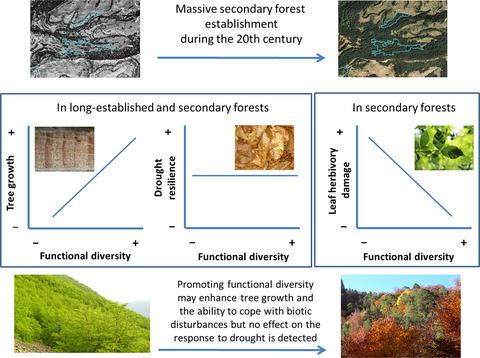当前位置:
X-MOL 学术
›
J. Appl. Ecol.
›
论文详情
Our official English website, www.x-mol.net, welcomes your feedback! (Note: you will need to create a separate account there.)
Functional diversity enhances tree growth and reduces herbivory damage in secondary broadleaf forests, but does not influence resilience to drought
Journal of Applied Ecology ( IF 5.7 ) Pub Date : 2020-07-30 , DOI: 10.1111/1365-2664.13728 Josep Maria Espelta 1, 2 , Verónica Cruz‐Alonso 1, 3 , Raquel Alfaro‐Sánchez 1, 4 , Arndt Hampe 5 , Christian Messier 6, 7 , Joan Pino 1, 2
中文翻译:

功能多样性促进次生阔叶林中树木的生长并减少草食动物的损害,但不影响抗旱能力
更新日期:2020-07-30
Journal of Applied Ecology ( IF 5.7 ) Pub Date : 2020-07-30 , DOI: 10.1111/1365-2664.13728 Josep Maria Espelta 1, 2 , Verónica Cruz‐Alonso 1, 3 , Raquel Alfaro‐Sánchez 1, 4 , Arndt Hampe 5 , Christian Messier 6, 7 , Joan Pino 1, 2
Affiliation

|
- Since the mid‐20th Century, Europe has experienced an unprecedented forest expansion associated with the abandonment of rural landscapes. Secondary forests may provide relevant ecosystem services such as landscape defragmentation, biodiversity conservation, control of hydrological cycling and carbon sequestration.
- Secondary forests may benefit from the legacies of the former agricultural land use, and exhibit enhanced growth. Moreover, they may differ from long‐established forests in terms of tree species composition and diversity, as community composition has been less modified by succession or management. However, we lack evidence whether the effects of land use legacies on tree species diversity may also result in differences in the response of secondary forests to biotic and abiotic disturbances.
- We aimed to evaluate the effects of land use legacies on taxonomic and functional diversity and their effects on the response of temperate broadleaf forests to drought and herbivory damage. For this aim, we compared secondary beech Fagus sylvatica forests established after 1950 in abandoned pastures with long‐established (pre‐1950) forests. We calculated indices of taxonomic and functional diversity and determined mean growth and growth response of beech to two drought events (1991, 2006), and insect herbivory damage.
- Secondary and long‐established beech forests marginally differed in species richness but the former exhibited a significantly higher Shannon diversity index and evenness. Yet, differences in taxonomic diversity did not result in differences in functional diversity between forest types.
- Mean tree growth was higher in secondary than in long‐established forests and it increased with functional diversity in both forest types. However, diversity was unrelated with the growth response to drought. Insect herbivory damage decreased with increasing functional diversity but only in secondary forests.
- Synthesis and applications. Promoting functional diversity in temperate broadleaf forests is a promising strategy for enhancing productivity (tree growth) while increasing the ability to cope with biotic disturbances (insect herbivory). This principle should be applied both in the management of long‐established as well as expanding secondary forests. Yet, functional diversity does not seem to ameliorate tree response to drought, highlighting the need for other silvicultural practices to address this environmental challenge.
中文翻译:

功能多样性促进次生阔叶林中树木的生长并减少草食动物的损害,但不影响抗旱能力
- 自20世纪中叶以来,欧洲经历了前所未有的森林扩张,这与放弃乡村景观有关。次生林可能提供相关的生态系统服务,例如景观碎片整理,生物多样性保护,水文循环控制和碳固存控制。
- 次生林可能会从以前的农业用地的遗产中受益,并表现出增长的趋势。此外,它们的树种组成和多样性可能与历史悠久的森林有所不同,因为群落组成因继承或管理而受到的影响较小。但是,我们缺乏证据表明土地利用传统对树种多样性的影响是否还会导致次生林对生物和非生物干扰的反应差异。
- 我们旨在评估土地使用传统对分类学和功能多样性的影响,以及它们对温带阔叶林对干旱和草食动物危害的响应的影响。为此,我们将1950年后在废弃草场上建立的次生山毛榉Fagus sylvatica森林与历史悠久(1950年前)的森林进行了比较。我们计算了分类学和功能多样性的指数,并确定了山毛榉的平均生长和对两个干旱事件(1991年,2006年)和昆虫食草害的生长响应。
- 次生和悠久的山毛榉森林物种丰富度略有不同,但前者表现出显着更高的香农多样性指数和均匀度。但是,分类学多样性的差异并未导致森林类型之间功能多样性的差异。
- 次生林的平均树木生长高于老龄林,两种类型的树木均随着功能多样性的增加而增加。但是,多样性与干旱的增长反应无关。昆虫的食草危害随着功能多样性的增加而减少,但仅在次生林中。
- 综合与应用。在温带阔叶林中促进功能多样性是提高生产力(树木生长)同时提高应对生物干扰(昆虫食草性)能力的一种有前途的策略。这项原则应适用于历史悠久的森林以及不断扩大的次生林。但是,功能多样性似乎并未改善树木对干旱的反应,这突出表明需要采取其他营林措施来应对这一环境挑战。



























 京公网安备 11010802027423号
京公网安备 11010802027423号